BYD invests 54.2 billion, Xiaomi 24 billion, but it is the one that is most willing to invest in R&D
![]() 04/03 2025
04/03 2025
![]() 536
536
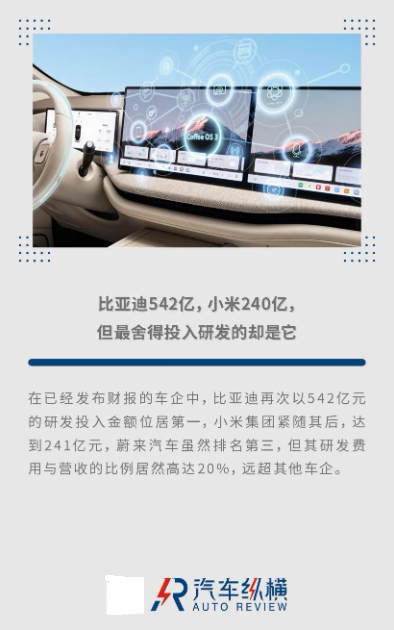
With the gradual release of automakers' 2024 annual financial reports, the R&D investment of various enterprises has also been announced.
Among the automakers that have released their financial reports, BYD once again leads other enterprises by a large margin with an absolute value of 54.2 billion yuan, and Xiaomi Group ranks second with 24.1 billion yuan. It should be noted that this is not the R&D investment amount of Xiaomi's automotive business. However, if sorted by the ratio of R&D expenses to revenue, NIO ranks first, with a proportion as high as 20%, far exceeding the 5%~8% of other automakers. It has to be said that in 2024, when NIO faced considerable operational pressure, it still invested one-fifth of its revenue in R&D, which can be described as being willing to "spare no expense." No wonder Li Bin, the founder, chairman, and CEO of NIO, stated bluntly in a recent media interview: "Everyone knows that NIO is under great pressure in terms of operations and needs to improve efficiency and reduce costs, but our investment in R&D and charging and battery swapping networks remains relatively firm. NIO should be one of the automakers with the highest proportion of R&D investment in revenue globally."
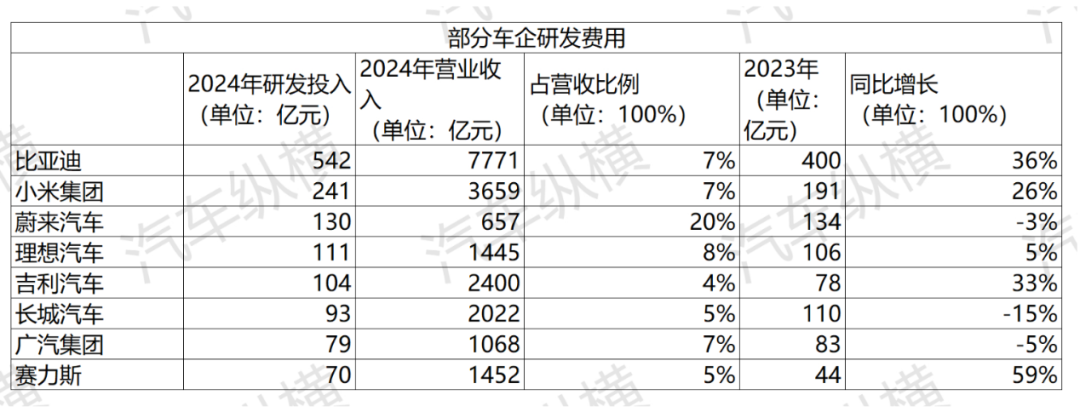
(Table made by Auto Review, data source: automaker financial reports)
BYD "far ahead", followed closely by Xiaomi
Financial report data shows that in the past five years, BYD's operating revenue has increased by approximately five times, and its net profit has increased by approximately 24 times. Behind the "surging" market sales and financial performance, BYD's R&D expenses have also increased year by year. According to the latest disclosed financial report, BYD's R&D investment in 2024 was approximately 54.2 billion yuan, a year-on-year increase of 35.68%, with cumulative R&D investment exceeding 180 billion yuan. BYD's total number of R&D engineers has exceeded 120,000, ranking first globally.
In 2022 and 2023, BYD's R&D investments were 20.223 billion yuan and 39.918 billion yuan, respectively, and the cumulative R&D investment in the past three years has reached 114.3 billion yuan. BYD proudly stated in its financial report that the company adheres to the development philosophy of "technology is king, innovation is fundamental." In 2024, BYD applied for 45 patents and received 20 patent authorizations on average each working day and successively released a series of groundbreaking technologies throughout the year. It is understood that BYD's R&D investment is mainly concentrated in three areas: battery technology, electric platforms, and intelligent driving. In 2024, BYD successively launched disruptive technologies such as the fifth-generation DM, Yisanfang, Tianshenzhiyan high-level intelligent driving, and super e-platform.
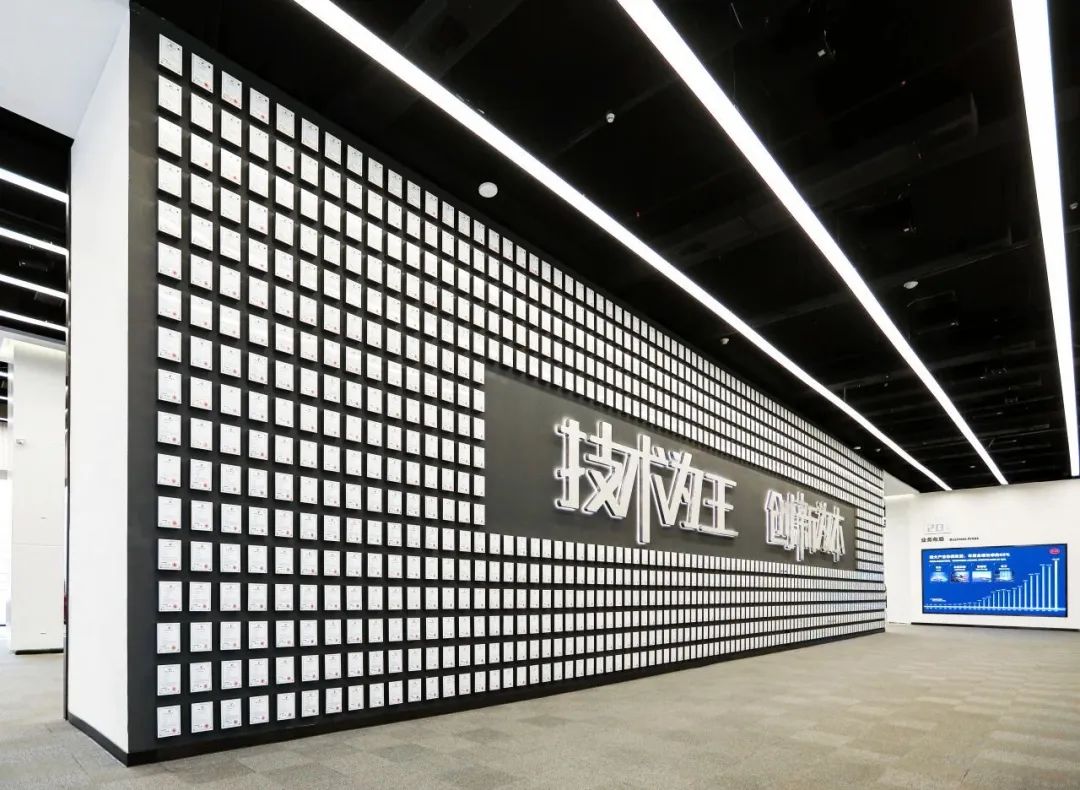
Xiaomi Automobile has also invested a lot of "real money" in R&D. At the recent China Electric Vehicle Hundred People Forum, Lei Jun, the founder, chairman, and CEO of Xiaomi Group, pointed out that five years ago, Xiaomi made up its mind to invest 100 billion yuan over five years. Now, five years have passed, and Xiaomi has invested approximately 105 billion yuan, with this year's R&D investment exceeding 30 billion yuan. Financial report information reveals that as of the end of December 2024, Xiaomi Group had obtained more than 42,000 patents globally, with over 1,000 patent authorizations related to smart electric vehicles.
Xiaomi stated in its financial report that the company has always adhered to investing in underlying core technologies and continues to deepen its efforts in the fields of intelligent driving, intelligent cockpits, three-electric systems, intelligent chassis, and other intelligent electric vehicle areas. In terms of intelligent driving, Xiaomi successively launched high-speed pilot assistance, urban pilot assistance, and "Xiaomi Intelligent Driving" based on the "end-to-end" and visual language large model in 2024, realizing a full-scenario intelligent driving experience from the starting point to the destination; Xiaomi's Penta Smart Cockpit, based on the interconnection capability of Xiaomi Penta OS, can deeply interact with mobile phones, in-car screens, and smart homes, realizing a closed-loop ecosystem of people, cars, and homes; in terms of hardware, Xiaomi Automobile has continuously innovated in motor design, material strength, efficient heat dissipation, and other technologies. Its self-developed and produced Xiaomi Super Motor V8s can reach a speed of 27,200 rpm. Xiaomi said that it will continuously enhance users' intelligent driving experience through technological innovation and iteration.
Recently, some media also reported that Xiaomi Automobile is poaching at least five senior executives from European automakers such as BMW to establish a European R&D center and accelerate its globalization process.
NIO is "still resolute in R&D investment"
Li Auto finally fulfills its dream of independently developing an operating system
Just as the saying goes, "No matter how hard things get, education must not suffer," there is also a saying in the automotive industry: "No matter how poor we are, R&D must not suffer." NIO Automobile has become the most forceful practitioner of this saying.
According to the latest financial report released by NIO, although the delivery volume, revenue, and gross margin increased in 2024, its losses continued to expand, with a net loss of 22.4 billion yuan during the year, an increase of 8.1% over the same period last year. Public data shows that from its establishment to the end of 2024, NIO's cumulative losses have exceeded 100 billion yuan. In response, Li Bin recently gave a direct response: "NIO's money is mainly spent on R&D." As Li Bin said, in 2024, NIO's revenue was less than half of Li Auto's, but its annual R&D investment was approximately 2 billion yuan higher than Li Auto's and even twice as much as XPeng's R&D expenditure.
Li Bin pointed out that NIO's R&D investment last year was 13 billion yuan, and the year before was 13.4 billion yuan, with an average quarterly investment of 3 billion yuan. Since its inception, NIO has cumulatively invested nearly 60 billion yuan in R&D. Industry insiders believe that NIO currently covers 12 full-stack technology layouts for smart electric vehicles, ranging from chips to in-vehicle intelligent hardware, operating systems, and vehicle engineering. For example, NIO's self-developed 5nm automotive-grade chip "Shenji NX9031" has been equipped on the NIO ET9, and its self-developed full-domain operating system "SkyOS•Tianshu" is also applied to the Ledo L60. However, as each technological field requires a significant amount of financial and time investment, and many of them are difficult to obtain obvious and direct returns in the short term, this has, to a certain extent, increased the financial pressure borne by NIO.
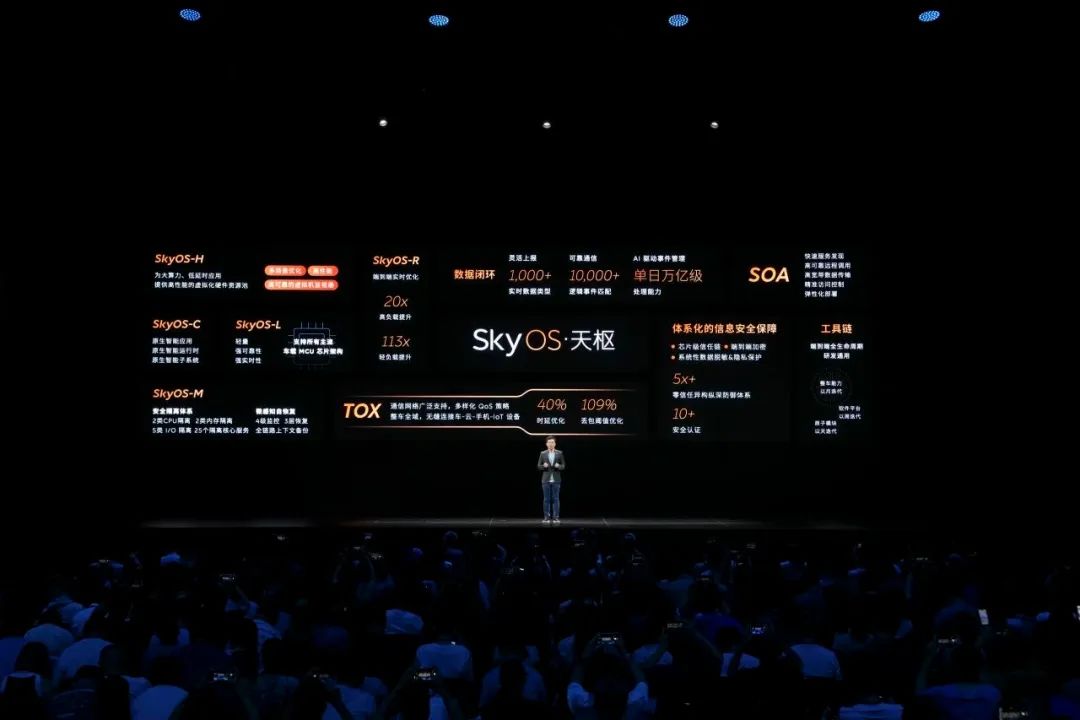
In 2024, Li Auto achieved a revenue of 144.5 billion yuan and a net profit of 8 billion yuan for the full year, becoming the first new force automaker in China to exceed 100 billion yuan in revenue for two consecutive years. It is worth emphasizing that although Li Auto's R&D expenses as a proportion of revenue in that year were not as high as NIO's, they were still higher than those of other automakers such as BYD and Xiaomi.
Financial report data shows that in 2024, Li Auto's R&D expenses reached 11.1 billion yuan, a year-on-year increase of 4.6%, with a significant increase in expenditures related to artificial intelligence. According to the financial report, Li Auto achieved 12 technological upgrades in the field of intelligent driving last year and fully pushed the map-independent NOA available nationwide to Li Auto AD Max users in July 2024. In October 2024, it fully pushed a new dual-system intelligent driving solution featuring full-stack self-developed end-to-end (E2E) and visual language model (VLM) to Li Auto AD Max users. One month later, Li Auto launched the "parking spot to parking spot" one-click intelligent driving and national highway toll station ETC autonomous passage functions based on this technology, achieving 100% coverage of daily driving scenarios.
At the annual conference of the Zhongguancun Forum in 2025, Li Xiang, the founder, chairman, and CEO of Li Auto, said that to realize the independent development of an operating system, Li Auto started in 2021, invested 200 R&D personnel and 1 billion yuan, and finally launched Li Auto Xinghuan OS, which was first applied to vehicles in 2024.
The effectiveness of traditional automakers' "elephant turning" is evident
On March 20, Geely Automobile delivered an impressive annual financial report. The report shows that in 2024, Geely Automobile's total revenue exceeded 240 billion yuan for the first time, a year-on-year increase of 34%, setting a new record; the annual net profit attributable to shareholders reached 16.6 billion yuan, a year-on-year increase of 213%.
In the view of industry insiders, behind this revenue increase, volume expansion, and all-round positive financial performance is the success of Geely's layout in various fields over the years. The financial report reveals that in the first half of last year alone, Geely's direct operating revenue from technology licensing reached 19.825 billion yuan, accounting for 18.5% of its non-vehicle business.
The considerable revenue from technology licensing naturally cannot be separated from the significant investment in R&D. Data shows that from 2020 to 2024, Geely's cumulative R&D investment exceeded 110 billion yuan. In 2024, Geely Automobile focused on new energy and intelligence, strengthened the core competitiveness of its products, and invested a total of 10.4 billion yuan in R&D, an increase of approximately 33% compared to the 7.8 billion yuan in 2023. Analysis points out that as the volume increases on a large scale and the profit and cost per vehicle improve, Geely's past investments in technology are gradually being diluted, ushering in a period of "dividends" and "harvests." It should be noted that Geely Automobile has also explored a development path that balances investment and efficiency. While increasing investment in core technology R&D, it also focuses on continuously improving R&D efficiency and driving product iteration and upgrades through technological innovation.
Like Geely Automobile, Great Wall Motor's years of deep cultivation also bore fruit in 2024: annual revenue exceeded 202.19 billion yuan, net profit was 12.69 billion yuan, and non-deducted profit increased by 101.4% year-on-year. The birth of such a performance report is inseparable from Great Wall Motor's continuous investment in R&D over the years. It is reported that currently, Great Wall Motor has 23,000 R&D personnel, and its R&D investment has exceeded 10 billion yuan for three consecutive years. It has currently established a technical route with "hybrid + pure electric + hydrogen energy" running in parallel. In addition, in terms of intelligence, Great Wall Motor has built the Jiuzhou Supercomputing Center with a maximum computing power of 5 EFLOPS, which can meet the computing power demands of hundreds of large-scale training sessions. Currently, Great Wall Motor's end-to-end Coffee Pilot Ultra intelligent driving covers the ADC2.0, 3.0, and 4.0 intelligent driving platforms, enabling products in different price ranges to match different intelligent driving solutions. According to the plan, in the future, Great Wall Motor's 100,000-yuan products will realize map-independent high-speed NOA.
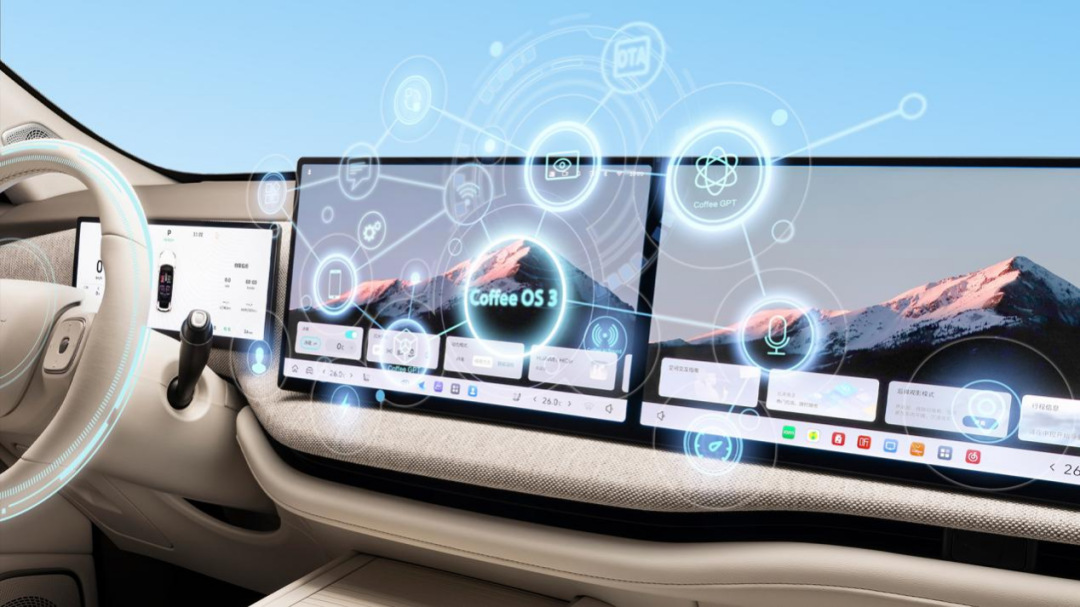
It should be emphasized that although from the perspective of single-year R&D investment expenses, traditional automakers may generally not match those of new-energy vehicle startups, the former have invested for a longer time and have deeper accumulations. Therefore, one cannot simply infer the technical strength and level of automakers based on a comparison of R&D expenses in recent years. In addition, the technology layouts of traditional automakers are mostly comprehensive and diversified, covering both new energy and intelligent connectivity, as well as traditional fuel fields. However, most new-energy vehicle startups are limited to new energy and intelligent connectivity technologies. Objectively speaking, traditional automakers still have the upper hand in the richness of the "technology tree."
R&D investment is the core driving force for automakers to maintain technological leadership, enhance product competitiveness, and adapt to the trends of electrification and intelligence. As the wave of technological change continues to surge, these substantial R&D investments will ultimately become an important factor in determining whether automakers can stand out and should receive further attention and emphasis.

Images: from the internet
Article: Auto Review
Typesetting: Auto Review








